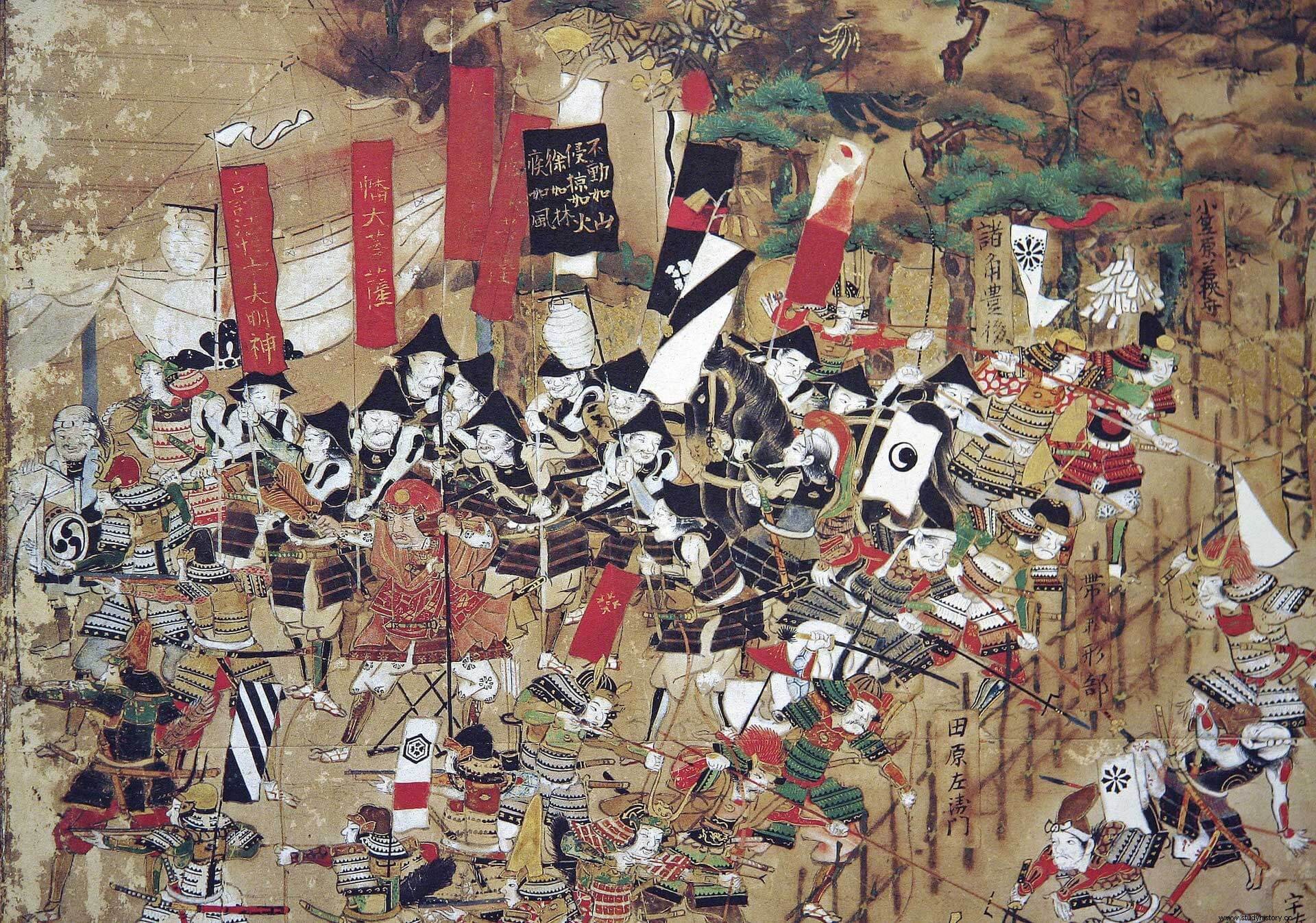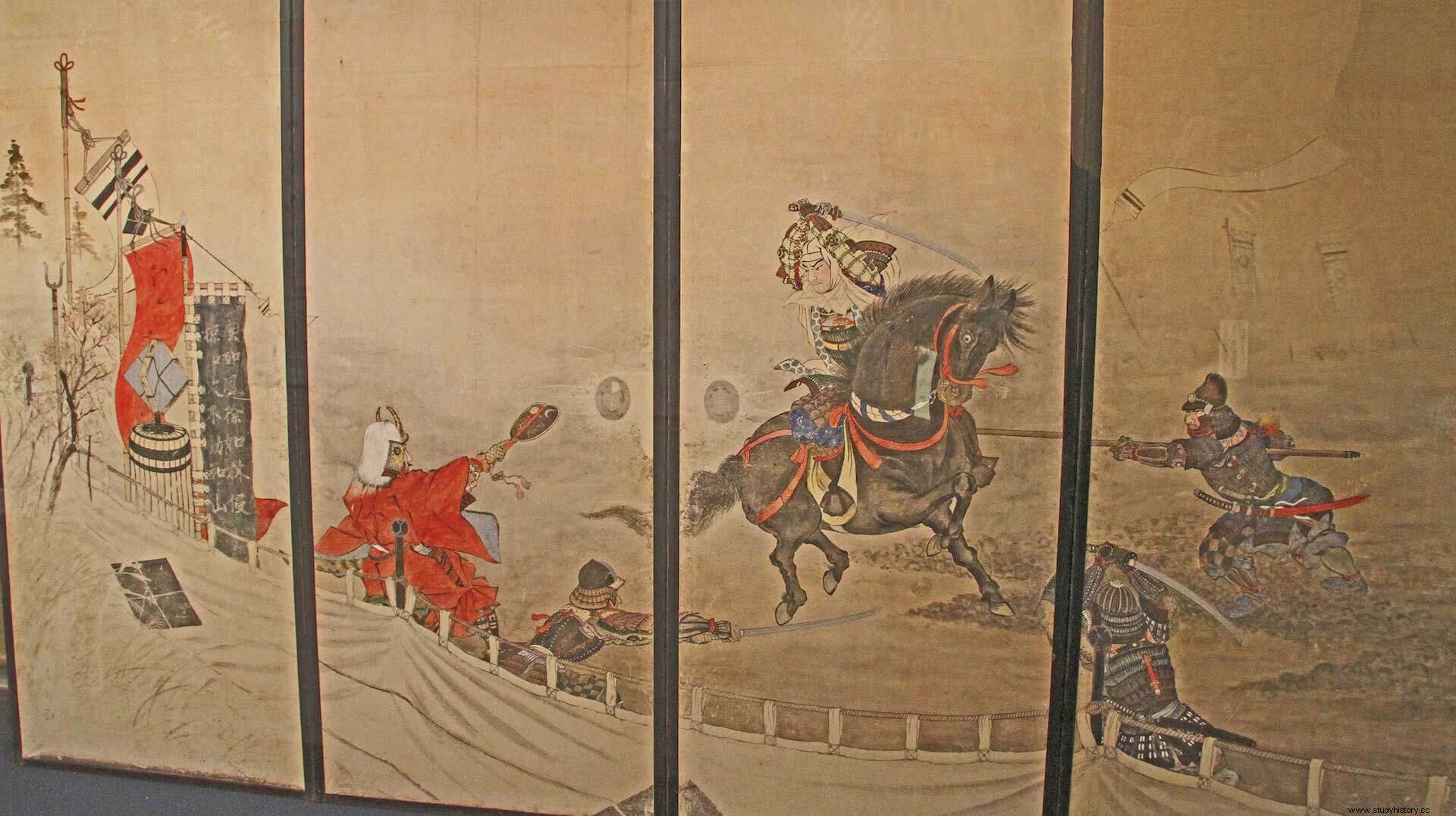Uesugi Kenshin attacks Shingen
The most widespread version of the ikkiuchi states that Uesugi Kenshin, when he assumed that he was losing the battle of Kawanakajima, entrusted everything to the possibility of ending his most bitter enemy. Driven by utter desperation, he charged on horseback at the honjin (headquarters) Takeda. There he found Takeda Shingen, sitting on his shōgi (field stool), reportedly armed only with his gunbai , his war fan, to defend himself.

Kenshin brandished his three shaku sword in length (about 90 cm) against Shingen's head, who barely managed to deflect the blow with his gunbai . One of the Takeda vassals, a hatamoto who answered to the name of Hara Ōsumi, came to the rescue of his lord and, wielding a spear, furiously attacked Kenshin, hitting him in the shoulder, behind the armor.
Uesugi Kenshin counterattacked, deflecting Ōsumi's spear with his sword, which then slammed into the horse's hindquarters with great force, rearing the animal and causing it to gallop away from the horse. camp and taking his rider with him. More Takeda soldiers rushed to the scene, but by then Kenshin was back in his own ranks.
Eight slash marks were subsequently discovered in the gunbai and, according to the sources, Takeda Shingen was said to have received two injuries to his arm as a result of the attack. This is the way the story has been told, but as with all isolated episodes, there are many questions and alternative versions.
The ikkiuchi in the sources
The Takeda sandai gunki collects a variant of the episode ikkiuchi in which Ōsumi attacked with his mochi-yari (throws) Uesugi Kenshin, knocking him off his horse, but one of the usesugi vassals rushed to the rescue, yielding his mount and allowing him to ride from Takeda Shingen's camp to the Sai River.
Another version can be extracted in the Uesugi-ke go nenpu , which claims that he was a hatamoto of Kenshin named Arakawa Nagazane who charged at the honjin takeda with his sword raised. Shingen, who hadn't had time to reach for his own sword, warded off the attacker by brandishing his gunbai . The samurai hatamoto Shingen finally came to the rescue and forced the attacker to retreat. Nagazane is said to have died that same day, although we do not know whether during the attack on Shingen or in the fighting that took place later.

Of all the various sources around the episode of the ikkiuchi , the letter written by Konoe Sakihisa (1536-1612), dated October 5, 1561, is the most interesting. This individual, from the Kantō area, wrote to Kenshin to praise him for his victory over Harunobu (Shingen) and, at the same time, for having fought sword in hand during the battle. Unfortunately, it is not mentioned who he fought against, and this ambiguity could have fueled later stories and legends that the combat was nothing less than a personal duel between the two commanders.
Sakihisa probably wrote this letter because of a letter he would have received earlier from Kenshin himself, although we don't know why. It was standard practice during this period, in fact, to brief allies, friends, and administrative leaders on various matters, and a major victory like this would have been a major event of its kind.
Sakihisa continues in his letter stating that Kenshin's name will be known throughout the country because of his personal display of bravery and great victory. Furthermore, he calls for his presence in the Kantō area as soon as possible, since Hōjō Ujiyasu from Odawara was attacking Matsuyama Castle.
Current revision of the ikkiuchi
This episode of the ikkiuchi it has been described in countless books and illustrated in innumerable engravings – especially those called ukiyo-e of the 19th century – and in other forms of art to the present day. There are no contemporary sources, however, to support the story. Many Japanese historians are therefore skeptical about the veracity of the episode and believe that it could have been made later.
When a person adopted the robes he traditionally shaved his head and adopted a monk's cowl ( gyōnintzutsumi ), headdress that was often used instead of the helmet. In this context, it would be useful to ask if Kenshin would have worn the white monkish headdress in which he is depicted as wearing as early as 1561, which is probably a chronological contradiction since he was not ordained a monk until 1570, or at least not officially. –The first time we see the name of Kenshin mentioned, which he adopted after his ordination, is in a letter dated December 13, 1570–.
Be that as it may, it cannot be stated categorically that the ikkiuchi episode did not take place; however, it is very likely that it was someone other than Kenshin who attacked Shingen's camp:possibly a kagemusha.
